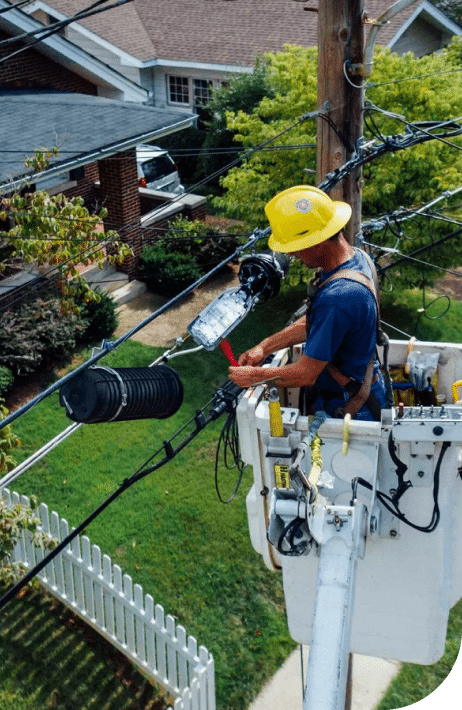Asbestos in Electrical Wiring
Asbestos wire insulation may be found in commercial and residential buildings. Electrical workers may be exposed to significant levels of asbestos when stripping, cutting, or modifying these wires or while repairing equipment where they are located.
Home » National Mesothelioma Law Firm » Asbestos Exposure » Asbestos in Consumer Products and Materials » Asbestos in Electrical Wiring
Products That Use Asbestos Electrical Wire
Electrical Wiring Components That Contain Asbestos
Why was asbestos used in electrical wiring?
Occupational Asbestos Exposure Through Electrical Wiring
How are workers exposed to asbestos through electrical wiring?
How can I determine whether electrical wiring is insulated with asbestos?
Should I replace electrical wiring that is insulated with asbestos?
Companies That Exposed People to Asbestos Through Electrical Wiring
Asbestos is a non-conductive insulating material that resists corrosion, moisture, fire, and high temperatures. This makes it an ideal substance for insulating electrical wires, especially when they are located in harsh environments, such as in high temperatures, underground, or areas prone to chemical or water infiltration.
Products That Use Asbestos Electrical Wire
Electrical wiring is present in nearly every building and industrial application. Live wires almost always require insulation. Asbestos wire insulation was most commonly used in products that generate extremely high temperatures, but it was used in multiple electrical applications where resistance to fire and other products was desired.
Asbestos electrical insulation was historically used in the following products:

- Cash registers
- Compressors
- Computers
- Construction equipment
- Conveyor systems
- Dental equipment
- Electrical transformers
- Fans and blowers
- Farm equipment
- Food industry machinery
- Furnaces
- Generators
- Heating and cooking appliances
- Hoists
- Industrial ovens
- Lamps
- Laundry equipment
- Lighting
- Machining tools
- Military aircraft, missiles, and weaponry
- Mining machinery
- Motors
- Oil burners
- Oil field machinery
- Paper mill equipment
- Portable power tools
- Pumps
- Radios
- Railroads
- Refrigeration units
- Switchgear controls
- Televisions
- Textile machinery
- Tractors
- Trucks
- Vacuum cleaners
- Vending machines
- Welding units
- X-ray machines
Electrical Wiring Components That Contain Asbestos
Asbestos in the wiring itself is sufficient cause for concern, but electrical wiring must be connected to a power source, the equipment being powered, safety devices, and controls. Several of these components also contained asbestos, including the following:
- Ceramic arc chutes used in motor starters and electric power plants
- High-grade electrical paper used in high-temperature, low-voltage applications, such as motors
- Millboard in circuit breakers
- Separators in fuel cells found in batteries
All of these components were banned by the Environmental Protection Agency in its April 2019 Final Rule.
Why was asbestos used in electrical wiring?
According to the Electronic Library of Construction Occupational Safety and Health, wiring insulation is almost always used on live electrical wires, with the exception of some ground wires, for the following safety reasons:
- It protects wires from coming into contact with other conductors, which could cause short circuits and fires.
- It prevents live wires from touching people or animals.
- It protects wires from physical damage in harsh environments, such as high temperatures.
Electrical insulation must be resistant to fire, moisture, corrosion, and fungus in order to effectively protect the wire and the surrounding environment. Asbestos has all of these qualities, and it is lightweight, making it an ideal insulating material, except for the health hazards.
A strong insulating material like asbestos can prevent fires when electrical shorts create sparks or an electrical arc occurs, resulting in a high-temperature arc flash that could ignite a catastrophic fire or instantly cause third-degree burns. While this only happens when there is an error, such as a circuit overload, a fire-retardant material like asbestos served as strong insurance.
Asbestos insulation was also valued for its ability to prevent arcing and short circuits by protecting the wiring from environmental factors thanks to its anti-corrosive, chemically inert, and thermal insulating properties. This made asbestos wire insulation especially useful in high-heat environments in such equipment as the following:
- Boilers
- Engines
- Furnaces
- Generators
- Industrial ovens
- Turbines

Occupational Asbestos Exposure Through Electrical Wiring
Although asbestos is an effective electrical wire insulator, the cost to human health is too high. Workers in the following occupations developed deadly diseases after being exposed to asbestos in electrical wiring:
- Airplane and aerospace workers
- Appliance installers
- Auto mechanics
- Boilermakers
- Carpenters
- Construction workers
- Electricians
- Engineers
- Factory workers
- Firefighters
- Heating, ventilation, and air conditioning workers
- Insulators
- Maintenance workers
- Military personnel
- Millwrights
- Oil refinery workers
- Power plant workers
- Remodelers
- Shipyard workers
These workers may still be exposed today when working in older buildings and on older industrial equipment.
How are workers exposed to asbestos through electrical wiring?
Workers who manufactured asbestos wire insulation, applied insulation to the wire, or installed asbestos-insulated electrical wiring experienced prolonged, heavy asbestos exposure. Boiler workers, engineers, millwrights, and other industrial maintenance workers may experience similar exposures as electricians.
Electricians
Electricians may have experienced significant asbestos exposure while installing and repairing wiring that was insulated with asbestos. Electrical wiring may release asbestos when it is cut, spliced, stripped, removed, or damaged. Damaged asbestos wire insulation inside electrical equipment may be released into the environment and inhaled the moment the equipment is opened for repair.
Electricians may be required to cut through asbestos-containing drywall, insulation, plaster, and other asbestos products to access electrical wiring in need of repair. Thus, the risk of heavy exposure is high.
Electricians often worked on construction sites and in industrial settings where they may have inhaled asbestos fibers released by other skilled workers such as insulators, drywallers, carpenters, and boiler workers.
A 2009 study published in the British Journal of Cancer found that carpenters, plumbers, painters, and electricians had the highest lifetime mesothelioma risks among construction workers born in the 1940s who worked for 10 or more years in their respective trades.
Firefighters and Military Personnel
Firefighters and military personnel may be exposed to asbestos in wiring insulation while fighting fires in older buildings or while working near building explosions or buildings that were recently destroyed. They also may be exposed while working on naval or Coast Guard vessels.
How can I determine whether electrical wiring is insulated with asbestos?
Asbestos wire insulation was common from 1920 to 1988. Asbestos insulation may be made of asbestos paper, loose cloth, or fabric that is braided or unbraided. In some cases, the insulation is impregnated with asbestos. Not all cloth or paper wire insulation contains asbestos, however.
The only reliable way to confirm the presence of asbestos is through testing by a licensed asbestos contractor. Asbestos particles are microscopic and cannot be seen by the naked eye. An asbestos contractor can test the wiring as well as the air quality.
Should I replace electrical wiring that is insulated with asbestos?
If the wiring and the insulation are in good repair and encased in an area, such as inside a wall, where it cannot release fibers into the environment, it may be safer to leave it in place. However, if you have the material tested, you should follow the advice of the asbestos abatement company.
Removal of asbestos wiring is an expensive, time-consuming process that should only be undertaken if testing reveals a hazard.
When asbestos is removed, the area must be sealed off with no entry by anyone other than the contractors. The asbestos must be wetted, sealed, and disposed of according to EPA guidelines. The contractors must wear the appropriate personal protective equipment and follow detailed procedures to prevent the fibers from escaping.
Companies That Exposed People to Asbestos Through Electrical Wiring
These asbestos companies were involved in the production, distribution, and/or use of asbestos wire insulation:
- Ace Hardware Corporation
- Appleton Electric, LLC
- Baldor Electric Company
- Bechtel Corporation
- Combustion Engineering
- Cooper Industries, Inc./Crouse-Hinds
- Eaton Electrical/Cutler-Hammer
- Emerson Electric Company/U.S. Electrical Motors
- Garlock Sealing Technologies
- General Electric Company
- Gould Electronics, Inc./ITE Electrical Products
- Hubbell Lighting, Inc./Prescolite, Inc.
- Leslie Controls
- Lightolier, Inc.
- Motors Liquidation Company
- North American Refractories Company (NARCO)
- Phelps Dodge Corporation
- RSCC Wire & Cable/Rockbestos-Surprenant Cable Corp.
- Raytech Corporation
- Rockwell Automation/Allen Bradley and Rostone
- Schneider Electric USA, Inc./Square D Company
- Sears, Roebuck & Company
- Siemens Energy & Automation, Inc./ITE Electrical Products Co.
- Special Electric Company, Inc.
- The Okonite Company, Inc.
- The Sherwin-Williams Company
- U.S. Steel/American Steel & Wire Co. Electrical Cable Division
- Westinghouse Electric Corporation
If you have developed an asbestos-related illness after working for these companies or being exposed to their products, you deserve significant compensation. These companies knew asbestos was harmful, but they chose to continue to profit from it rather than alert the public.
You may be eligible to file a mesothelioma lawsuit. Some of these companies have declared bankruptcy after becoming overwhelmed by their asbestos liabilities. They have established asbestos trust funds as part of their Chapter 11 reorganization. This allows eligible asbestos exposure victims to file a claim without going to court.
How The Lanier Law Firm Can Help
If you have contracted mesothelioma or another asbestos-related illness after working with asbestos electrical wiring insulation, we may be able to help you recover substantial compensation. We have more than 30 years of experience helping people who were wrongfully exposed to asbestos recover significant damages.
Our record-setting settlements and verdicts include a $2.3 million verdict for an electrician who contracted mesothelioma after working in a naval shipyard. This is more than a number to us. It is a difference we were able to make in our client’s life.
Our mesothelioma lawyers care about our clients, and we are passionate about holding asbestos companies accountable. Contact us today to schedule a free case evaluation.
By submitting this form, you agree to our terms & conditions. Please read the full disclaimer



